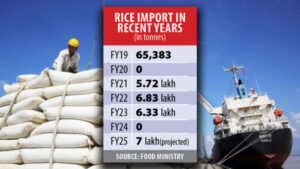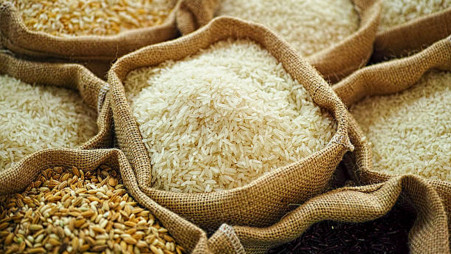“The cost of living has increased due to various reasons in the last few years, and in the meantime, due to natural disasters, the price of rice in the market is high,” Food Adviser Ali Imam Majumder told The Daily Star. The interim government plans to import seven lakh tonnes of rice, the most in the last seven fiscal years, in an effort to supplement its dwindling food grain stock and alleviate the cost of living crisis for low- and fixed-income individuals impacted by the prolonged high inflation. According to data from the Bangladesh Bureau of Statistics, inflation averaged 10.87 percent in the first half of fiscal 2024–25.
He added that the rice would be imported from multiple nations this fiscal year. “Therefore, this decision has been taken to relieve people from suffering to some extent,” he said. Initially, it was projected that approximately 10 lakh tonnes of rice would require importation. Later, it was revised down to seven lakh tonnes, The Daily Star has learnt from food ministry officials involved with the proceedings.
Currently, the process of importing 5.50 lakh tonnes of rice is underway. Of this, 3 lakh tonnes will be imported through an open tender process. The government has finalised plans to import 100,000 tonnes of rice from Myanmar on a government-to-government arrangement.
The first consignment of 27,000 tonnes has already reached the country, and another shipment will arrive later this month, Majumder said.
The move comes at a time when the the price of fine rice has grown by 4.05 percent in the previous month, medium-grain rice by 3.31 percent and coarse rice by 6.67 percent. And in the past year, the price of fine rice has climbed by 12.41 percent, medium-grain rice by 15.74 percent and coarse rice by 9.80 percent. Data from the Trading Corporation of Bangladesh shows that the prices of fine rice, coarse rice, and medium-grain rice are Tk 70 to Tk 84 per kg, Tk 54-58 per kg, and Tk 60-65 per kg, respectively.
According to a US Department of Agriculture assessment released in the third week of December, over three lakh hectares of crops were destroyed by two separate floods that occurred in August and October of last year. The research also stated that the current marketing year of 2024–25, which started in May of last year, may see a decline in rice output as a result of the decrease in Aman season paddy acreage. According to Majumder, the nation now has a sufficient supply of rice, and all essential precautions have been taken to avoid shortages in the future.
According to Mohammad Jahangir Alam, a professor in the Department of Agribusiness and Marketing at Bangladesh Agricultural University, the government’s initiative to import rice, both at the government and private levels, is a positive step towards bringing down the rice prices and alleviating people’s suffering. As of January 12, the public stock of food grains stood at 12.25 lakh tonnes, including 8.2 lakh tonnes of rice, down 25% year-over-year.
“Because, the upward trend in rice prices appears to be beyond control.” Alam also underlined the significance of taking transportation costs into account when importing rice, but added that a thorough analysis is necessary to ascertain whether the price increase is only the result of a shortage of supply or if there are other factors at play.
“If rice is sourced from distant countries, transportation costs will rise, which could lead to higher prices for consumers. Therefore, priority should be given to importing from countries that minimise transportation expenses.” He cautioned that excessive imports beyond the country’s demand could adversely affect local farmers, urging the government to carefully balance imports with domestic production.
He urged the government to carefully balance imports with domestic production, warning that excessive imports beyond the nation’s demand could negatively impact local farmers’ livelihoods. “The impact on farmers should not be overlooked,” he added.
Source: The Daily Star 



















